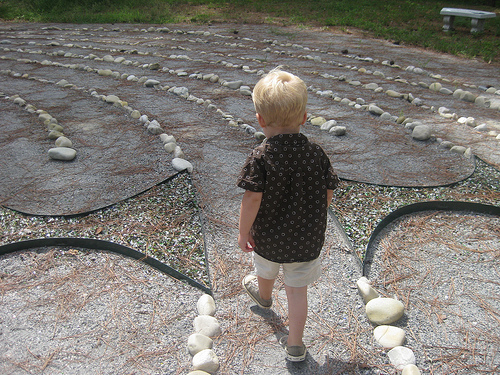opinion
In the grip of the past
Maybe it’s because my programme on Mindfulness for Coaches with Michael Chaskalson is about to start. Maybe it’s because I’m noticing more stress in my clients as they deal with anxieties and pressures. Maybe it’s because I notice I feel palpably calmer and fresher when I do my mindfulness practice. Whatever the reason, I’m especially aware at the moment of thinking being opened up and outcomes being generated when leaders become aware of the present moment and free themselves of some old patterns and beliefs. Family patterns, for example, are both strong and subconscious, and until they surface into awareness they keep going on a loop, reproducing old messages but not generating new solutions. This was the case for my client who, as a child, took on responsibility for keeping the family on track when his parents separated and the family entered a phase of disorder and instability. As leader he was driven by control, micromanagement and overworking – not ideal behaviour when you reach Board level. Only when he became mindful of his feelings and thinking did the pattern change.
Regretting past errors
Other clients have spent precious mental energy on regret or guilt over past events or errors, in the course of which they denied their real capabilities the opportunity to deliver the results their organisations needed. Focusing on, and accepting, things as they actually were released potential – and energy – they hadn’t previously been aware of.
What mindfulness is
I’ve seen a mindful approach deliver significant value to clients in the simplest – and yet the most powerful – of ways. Mindfulness allows us to slow down the mad rush that many of us find ourselves in on a daily basis, and opens up the space to be aware of thoughts, feelings, and physiological responses. According to Professor Mark Williams, of the University of Oxford, UK, mindfulness is “a direct, intuitive knowing of what you are doing while you are doing it. It’s knowing what’s going on inside your mind and body, and what’s going on in the outside world as well. Mindful awareness is about learning to pay attention, in the present moment, and without judgement. It’s like training a muscle – training attention to be where you want it to be. This reduces our tendency to work on autopilot, allowing us to us choose how we respond” (see more at, for example, http://www.mindfulnet.org/).
Consequences of mindfulness
In becoming more aware of what’s happening, I’ve seen clients – and I’ve experienced this myself too – discovering a new kind of clarity about what’s at the heart of a problem, choosing an emotional response to a given situation (rather than being at the mercy of emotions), and gaining a sense of calm which creates more effective thinking.
And all it takes is to dedicate a few minutes to focus on what you’re aware of. Even three minutes to become aware of your breathing can have significant effects. Indeed the neuroscience shows us that practising mindfulness on a regular basis actually changes the state of the brain so as to more consistently produce a mentally clear and alert state.
Dealing with stress
Pressure to deliver on targets, the stress of multiple, complex demands, and even trauma (which I see from time to time amongst my clients in clinical practice or working in war zones), the threat of change and the imperative to cope with transition – all these require leaders to think clearly, to make decisions in full awareness of what they’re doing and of what’s driving them, and to avoid getting hijacked by unhelpful emotions. Stress levels at work are arguably higher than at any time in history, and leaders I’ve coached manage it more effectively when they’re mindful.
A leader who breathes
I recently met up again with a previous client, a highly accomplished leader, who is under more pressure in an increasingly complex environment than she ever has been. And she’s producing results she couldn’t have dreamed of before her coaching programme: she’s making more impact at the highest levels than she ever has done, and she’s enabling her team to release more of their potential than ever. ‘What’s stayed with you from your coaching programme?’ I asked her. She gave me a list in response, the first item of which was ‘Breathing’. Ironic and striking that she has created some of her best results by becoming profoundly aware of the most fundamental gift we have as human beings: to breathe.
Photo by Ruby Sinreich via Compfight
Mindfulness, leadership and results
Mindful awareness is about learning to pay attention, in the present moment, and without judgement. It's like training a muscle - training attention to be where you want it to be. It's a valuable tool for impactful leadership.
Read more »Building blocks of healthy relationships: autonomy
Leaders who treat their people as autonomous adults are likely to get the best out of them: an autocratic style gets quick, short-term results but anything less than an empowering style doesn’t adequately nurture the discretionary effort and engagement that are essential for organisational success.
Read more »Building blocks of healthy relationships: respect, care and listening
Through healthy relationships individuals flourish, they become balanced and resilient, and they contribute to the world around them with energy and commitment. In such circumstances it’s relatively easy for people to learn how to manage their emotions by articulating them and being heard rather than judged. The messages for leadership are clear.
Read more »Relationships: the leader’s secret weapon
Leaders are sometimes tempted to focus on the task and the process for fulfilling that task. Such an approach may bring short-term results, but the real differences are made when the leader focuses on strengthening relationships, listening and building trust.
Read more »Neuroscience and the leader
We all have not one but several selves, and several self-esteems, and it is in part the job of the coach to enable the coaching client to raise their awareness of their range of selves rather than of one self. Self-esteem varies according to context and we have several self-esteems alongside our several selves. The coach can play a valuable role in working with the coaching client to uncover and manage those self-esteems.
Read more »The path to authentic leadership
An authentic leader is true to himself or herself, who therefore engenders trust, who leverages the potential of diversity, and who is able to manage with integrity the tensions between their own agenda and that of their organisation. The first and most fundamental step on this path is the journey towards self-awareness.
Read more »The authentic leader
We all deliver our best by being who we are – and for most of us that means learning how to become who we are. Leaders who accept and embrace their authenticity often find both personal peace and an energy and focus that means they leverage their strengths with courage and assertiveness and empower their teams to deliver authentically too.
Read more »Leaders in the firing line: on integrity, commitment and passion
I’m privileged to be coaching UNICEF leaders again. They need a challenging blend of mastery of people skills, diplomatic skills, technical skills, knowledge, vision, initiative, adaptability, resilience and endurance. Stress levels are high, and the most basic resources in their environments are often lacking. Their integrity and their passion for their cause – the promotion and defence of children’s rights, survival, security and protection – are dazzling and humbling. It’s unbelievably inspiring and energising to be working with them.
Read more »Trust: a critical element of leadership
Trust is a key enabler to getting the results that organisations need. Leaders need to nurture relationships at work and need to be able to trust their teams. And their teams need to be able to trust them too. One of the outcomes of development of this kind is that leaders find themselves getting more from their teams without much apparent effort. They find that the members of those teams take more initiative and more responsibility,
Read more »Approaching the finishing line of the 30 Day Challenge
The 30 Day Challenge draws to a close. I've been challenged, supported, and held accountable, and I've gained some insights. I'm learning about blogging - and about topics I'd never anticipated - and I'm surprised at how much I'm enjoying the blogging process. I'm on the alert for topics to blog about - and now that I'm blogging twice a week, I feel 'in the groove'. My next step is to ensure that my blog is read and to build a readership.
Read more »











